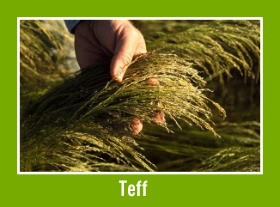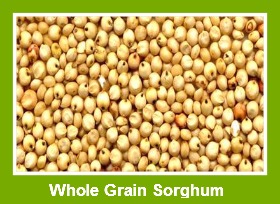Ask Shelley Case: Whole Grains and the Gluten-Free Diet
Question:
I’ve heard that whole grains are important but I’m confused about gluten-free whole grains and how to incorporate them into my diet… Please help!
 Answer:
Answer:
Why Whole Grains?
Individuals who regularly eat whole-grains have a lower risk of obesity, lower cholesterol levels and a reduced risk of heart disease, strokes, Type 2 diabetes and certain types of cancers. For those on a gluten-free diet, getting enough gluten-free whole grains can be a bit more challenging. But with a little insight, education, tips and recipe ideas gluten-free whole grains can easily be incorporated into a gluten-free diet and open up a whole new way of eating and good health!
What are Some Gluten-Free Whole Grains?
There are a wide variety of gluten-free whole grains…amaranth, brown rice, buckwheat, corn, Montina™ (Indiana ricegrass), millet, oats (pure, uncontaminated*), quinoa, sorghum, teff, and wild rice. A grain is considered “whole” when it is consumed in a form that includes the bran (or the outer layer and primary source of fiber), germ (or the part that sprouts into a new plant) and endosperm (or the bulk of the seed).
*The majority of commercial oat products on the market are cross-contaminated with wheat, rye or barley which occurs during harvesting, transporting, storing, milling, processing and packaging. The good news is that there are companies in the US, Canada and Europe who produce pure, uncontaminated specialty gluten-free oat products. The North American companies are Bob’s Red Mill, Cream Hill Estates, Avena Foods (Only Oats™), Gifts of Nature, GF Harvest (formerly Gluten Free Oats) and Legacy Valley (Montana Monster Munchies).
The Recommended Amounts of Whole Grains
The new 2010 Dietary Guidelines for Americans recommend that at least half of your grain servings per day should be whole grains. The Guidelines and Whole Grains  Council recommend at least 3 to 5 servings of whole grains per day. The average adult who consumes 2000 calories/day (the amount on the nutrition label), should eat 6 grain servings a day – making at least half of them whole grains. To make things simple and find smart choices, look for the yellow Whole Grains Stamps that have been developed by the Whole Grains Council.
Council recommend at least 3 to 5 servings of whole grains per day. The average adult who consumes 2000 calories/day (the amount on the nutrition label), should eat 6 grain servings a day – making at least half of them whole grains. To make things simple and find smart choices, look for the yellow Whole Grains Stamps that have been developed by the Whole Grains Council.
An example of one serving of gluten-free whole grains include:
- ½ cup cooked amaranth, brown rice, buckwheat groats, millet, oat groats, quinoa, sorghum, teff or wild rice
- ½ cup cooked brown rice pasta
Tips for Adding Whole Grains to Your Gluten-Free Diet
The following tips are from the resource “Whole Grains and the Gluten-Free Diet” by Carol Fenster and Shelley Case.
http://www.glutenfreediet.ca/img/WholeGrains2.pdf
- Add cooked buckwheat, oat groats, steel-cut oats, quinoa, sorghum or wild rice to rice pilaf
- Enrich soups with cooked brown rice, buckwheat, oat groats, quinoa, sorghum or wild rice
- Boost nutritional content of brownies, cakes and cookies with ¼ cup cooked amaranth or teff
- Sprinkle cooked whole grains over mixed green salads
- Toss cooked whole grains with gluten-free pasta
- Start the day with a High Fiber Hot Cereal
- Dress cold cooked whole grains with pesto or a zesty salad dressing like this recipe for Quinoa Tabbouleh.
- Blend cooked oat groats or brown rice with black beans or pinto beans in Southwestern dishes
- Extend hamburger patties or meat loaf with gluten-free rolled oats or cooked brown rice, quinoa, amaranth or teff
- Replace ¼ of the cornmeal with teff grains for a cornmeal-teff polenta
- Add cooked amaranth, quinoa or teff to puddings for interesting texture
- Cook hot cereal for breakfast from Ancient Harvest quinoa flakes, Bob’s Red Mill Mighty Tasty GF Hot Cereal, The Birkett Mills’ buckwheat flakes or gluten-free rolled oats
- Use quinoa flakes, gluten-free rolled oats or gluten-free cold cereals and granolas to top fruit crisps
- Choose pasta that is made with quinoa (e.g., Ancient Harvest, GoGo Quinoa) or added rice bran (e.g., Tinkyada, DeBoles GF Multi-Grain)
- Choose baking flours such as amaranth, brown rice, buckwheat, Montina™, quinoa, sorghum, teff or wild rice because they are ground from the whole grain
- Add cream of buckwheat cereal to homemade breads
- Enjoy popcorn as a nutritious snack
- Choose whole grain crackers (e.g., Mary’s Gone Crackers, Crunchmaster Multi-Grain Crackers)
More Information about Gluten-Free Whole Grains
To learn more about the nutritional composition, cooking tips, recipes, and companies who provide gluten-free whole grains, read “Whole Grains and the Gluten-Free Diet” by Carol Fenster, PhD and Shelley Case, RD.
Ask Shelley Case is a feature of BeFreeForMe.com. It is published the second Tuesday of each month. Shelley Case, RD is a Consulting Dietitian, Speaker and Author of Gluten-Free Diet: A Comprehensive Resource Guide. Visit Shelley and get more gluten-free tips & info at: GlutenFreeDiet.ca
September 13th, 2011 at 8:08 am
Thank you, very helpful question and answer.
September 13th, 2011 at 3:31 pm
WOW! We’ve had thousands and thousands of you open this blog post since this morning! Do you have a question for Shelley regarding this post? If so, post a comment – and she’ll get back to you as soon as possible.
Nancy sent us an email and asked:
Can amaranth be used the same way as quinoa? I understand that is a good whole grain for us to use, too. I’m not familiar with it at all. Thanx / Nancy
Stay tuned for the answer!
Be Free!
Kathleen
September 13th, 2011 at 5:55 pm
Thank you so very much for the concisely presented up-to-date information. I’ve already made a print-out of pages 1-3 to post in my kitchen!
September 13th, 2011 at 6:28 pm
Amaranth is a broad-leafed plant that produces florets containing thousands of tiny grain-like seeds. The seeds range in color from off white, tan or light brown and have a slightly sweet, nutty and toasty flavor. This nutritious gluten-free grain is high in iron, protein, fiber, calcium and other nutrients. Amaranth is available as a whole seed, flour, toasted bran flour, puffed cereal and snacks.
To cook the whole grain amaranth seed combine 1 part amaranth with 2 parts liquid (water, gluten-free broth or fruit juice) in a heavy-bottomed saucepan. Bring to a boil and then gently simmer for approximately 20-25 minutes or until all the liquid is absorbed. Stir frequently to prevent lumps. Do not overcook, as it becomes gummy. Turn off the heat and let stand, covered, for five minutes. Serve as a side dish to replace rice or potatoes. It can also be mixed with beans for a main dish; added to rice and cooked together for a unique flavor; used to thicken stew or soups.
For a hot cereal, cook in fruit juice or water. Add chopped dried fruits, nuts, cinnamon and nutmeg. You can also add a spoonful of brown sugar, honey or maple syrup.